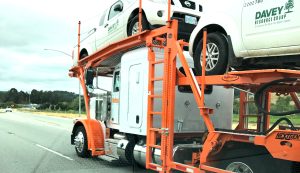Understanding Honolulu ‘s Vehicle Inspection Requirements
When moving to Honolulu or purchasing a vehicle on the islands, it’s crucial to understand the state’s stringent vehicle inspection requirements. These inspections are mandated by law to ensure that all vehicles meet safety and environmental standards, contributing to the overall well-being of drivers and the environment alike.
Upon delivery of your vehicle in Honolulu , you will need to undergo a comprehensive safety inspection. This inspection is not just a formality; it is an essential process that examines various aspects of your vehicle to ensure it complies with state regulations. The safety inspection covers critical components such as brakes, tires, lights, steering mechanisms, and exhaust systems. Furthermore, if your car is equipped with tinted windows, they must adhere to Honolulu ’s specific tint laws regarding light transmission percentages.
The initial safety inspection must be completed within 30 days of registering your vehicle in Honolulu . This timeline ensures that new residents or newly purchased vehicles quickly comply with local standards. The good news is that many certified service stations across the islands are authorized to conduct these inspections, so finding a convenient location shouldn’t be difficult.
Moreover, this isn’t just a one-time requirement; annual re-inspections are mandatory for all vehicles registered in the state. Upon passing the inspection, you will receive an official sticker that must be displayed on your rear bumper as evidence of compliance.
Understanding and adhering to these requirements can save you from legal complications and potential fines while ensuring that your vehicle remains safe for use on Honolulu an roads. By prioritizing this process upon delivery of your vehicle in Honolulu , you contribute positively to road safety and environmental conservation on the islands.
Pre-Delivery Checklist For Your Vehicle
When your vehicle arrives in Honolulu , it’s crucial to conduct a thorough inspection to ensure it has arrived in the condition promised and is ready for use. The pre-delivery checklist serves as an essential guide for what you should examine before accepting the vehicle from the shipping company.
First, assess the exterior of the car meticulously. Look for any visible dents, scratches, or paint chips that could have occurred during transit. Pay close attention to areas that are prone to damage such as bumpers, doors, and mirrors. It’s advisable to compare your findings with photos taken before shipment if available.
Next, move on to checking the interior of the vehicle. Verify that all electronic systems are functioning correctly; this includes lights, indicators, air conditioning, and audio systems. Inspect seats and upholstery for any tears or stains that were not present prior to shipping.
Under-the-hood checks are equally important. Ensure fluid levels such as oil, coolant, brake fluid, and windshield washer fluid are at appropriate levels. Verify that there are no leaks or unusual odors emanating from the engine compartment.
Additionally, examine the tires for wear and tear or any punctures that might have occurred during transportation. Ensure they are inflated according to manufacturer specifications.
Do not overlook verifying documentation like registration papers and shipping receipts against what was agreed upon initially. Any discrepancies should be promptly reported to both the shipping company and insurance provider.
Conducting this comprehensive pre-delivery inspection helps guarantee that your vehicle is safe and functional upon its arrival in Honolulu while providing peace of mind by documenting its condition post-shipping accurately.
What To Expect During The Inspection Process
When your vehicle arrives in Honolulu , the inspection process is a crucial step to ensure it meets local regulations and is in good operating condition. The inspection typically starts with a thorough examination of the exterior. Inspectors will check for any damage that may have occurred during shipping, such as dents, scratches, or other signs of wear and tear. It’s important to document any issues immediately to address them with your shipping company.
Next, the focus shifts to verifying that your vehicle complies with Honolulu ‘s safety and environmental standards. This involves checking essential systems like brakes, steering, suspension, and tires. The inspectors will also examine lights, mirrors, windshield wipers, and seat belts to confirm they are functioning correctly.
An emissions test is another key component of the inspection process. Honolulu has stringent environmental regulations aimed at reducing pollution; therefore, your vehicle must pass an emissions test before it can be registered. This involves measuring the levels of harmful gases emitted from your exhaust system.
The interior of your vehicle will also receive attention. Inspectors will look for any signs of water damage or mold that might have developed during transit. Additionally, they’ll ensure that all dashboard indicators are working properly.
One should be prepared for potential delays if any issues are found during this process. Minor problems can often be resolved quickly on-site; however, more significant issues may require repairs before you can complete registration.
Overall, the inspection ensures that your vehicle is safe for use on Honolulu an roads and compliant with local laws. Being aware of what to expect can help you navigate this process smoothly and efficiently once your car arrives in paradise.
Required Documents For Vehicle Inspection In Honolulu
When preparing for a vehicle inspection in Honolulu , it is essential to gather and present specific documents to ensure the process is seamless and compliant with local regulations. One of the primary documents required is proof of ownership, typically demonstrated through the vehicle’s title or a bill of sale if the car was recently purchased. This document establishes your legal right to possess and register the vehicle within the state.
Additionally, you will need to present a valid form of identification. This can be a Honolulu driver’s license or an out-of-state driver’s license if you are new to Honolulu . The identification helps verify that you are authorized to conduct business related to the vehicle under your name.
Another critical document is proof of insurance that meets Honolulu ‘s minimum coverage requirements. The state mandates liability insurance as part of its no-fault insurance system, ensuring that all vehicles on public roads have adequate protection in case of accidents.
For vehicles being shipped from outside Honolulu , especially from other states or countries, you’ll need documentation proving that any applicable taxes and fees have been paid. If your vehicle is coming from another country, additional customs documentation may be necessary.
Finally, if your vehicle has undergone any significant modifications or repairs prior to shipment or during its stay on the mainland, receipts or certificates related to these changes might be required during inspection. These documents help inspectors assess whether alterations comply with safety standards set by Honolulu an law.
Ensuring you have all these documents ready before your inspection appointment can facilitate a smooth process, helping you get your vehicle road-ready without unnecessary delays. Being well-prepared not only expedites compliance but also demonstrates responsible ownership in adhering to Honolulu ’s strict vehicular regulations.
Common Issues Identified During Inspections
When your vehicle arrives in Honolulu , conducting a thorough inspection is crucial to ensure it has been transported safely and without damage. Several common issues tend to be identified during these inspections, stemming from both the shipping process and general wear and tear. Recognizing these problems early can save you time, money, and hassle in the long run. One frequent issue is external damage to the vehicle’s body.
Scratches, dents, and paint chips can occur during transport due to shifting cargo or contact with other objects. Inspecting every inch of your car’s exterior will help you spot any new imperfections that need addressing. Another area of concern is undercarriage damage. The underside of your vehicle can be susceptible to scrapes or more significant harm from loading ramps or debris encountered during transit.
A careful examination underneath the car can reveal these hidden damages that might otherwise go unnoticed but could lead to serious mechanical problems if left unaddressed. Mechanical issues are another critical aspect of post-delivery inspections. Shipping conditions could potentially affect various systems such as brakes, transmission, and suspension components. Checking fluid levels like oil, coolant, and brake fluid can also indicate whether there have been any leaks or irregularities during transit.
Moreover, tire condition should not be overlooked. Inspect each tire for punctures or excessive wear that might have occurred en route. Pay close attention to air pressure levels as well; fluctuating temperatures during transport can cause tires to lose pressure. Lastly, interior conditions should also be reviewed for any signs of water damage or mold growth due to changes in climate conditions while at sea.
Ensure electronic components are functioning correctly as well; connectors might loosen or corrode due to humidity exposure.
Steps To Take If Your Vehicle Fails Inspection
If your vehicle fails inspection upon delivery in Honolulu , it’s important not to panic. The first step is to understand why your vehicle didn’t pass. The inspection report will detail the specific areas where your vehicle failed to meet the required standards. Carefully review this report to pinpoint the exact issues that need addressing.
Once you have identified the problem areas, consult a reputable mechanic or auto repair shop familiar with Honolulu ‘s vehicle inspection requirements. They can provide an estimate for repairs and offer guidance on which issues are most urgent. It’s crucial to choose a mechanic who understands local regulations since they can ensure that all necessary fixes comply with state laws.
After obtaining a repair estimate, prioritize fixing the most critical issues first, especially those that affect safety and emissions, as these are often the primary reasons for inspection failures. Depending on the complexity of the needed repairs, you might be able to address some minor issues yourself if you’re mechanically inclined.
Keep all receipts and documentation related to the repairs. This paperwork will be essential when you return for a re-inspection because it demonstrates that you’ve taken steps to remedy the problems identified during the initial assessment.
Once repairs are complete, schedule a re-inspection at an authorized inspection station in Honolulu . Make sure you bring along all necessary documents including your original inspection report and any repair receipts.
If your vehicle passes upon re-inspection, you’ll receive an updated certificate indicating compliance with state regulations. However, if it fails again, review any new deficiencies noted by inspectors and repeat the process until compliance is achieved.
Throughout this process, maintain open communication with both your mechanic and inspection station staff; their expertise can help ensure a smoother path toward getting your vehicle road-ready in Honolulu .
Tips For A Smooth Vehicle Delivery And Inspection Experience
When it comes to ensuring a smooth vehicle delivery and inspection experience in Honolulu , preparation and attention to detail are key. First, familiarize yourself with the specific requirements and procedures set forth by the Honolulu Department of Transportation. This includes understanding any necessary documentation, such as registration papers, proof of insurance, and shipping receipts. Having these documents readily available will streamline the process.
Before your vehicle arrives, communicate clearly with the shipping company about delivery timelines and locations. Confirm whether your presence is required during the inspection or if someone else can act on your behalf. Being present allows you to address any issues immediately.
Inspecting your vehicle upon delivery is crucial for identifying any potential damage that may have occurred during transit. Conduct a thorough examination of both the exterior and interior of the car. Pay close attention to areas that are often overlooked, such as undercarriages and wheel wells. Document any damages with photographs and written notes; this evidence will be essential if you need to file a claim with the shipping company.
Additionally, check all fluid levels including oil, coolant, brake fluid, and windshield washer fluid to ensure they are at appropriate levels after transport. Test all electronic systems like lights, wipers, and indicators to confirm they are functioning correctly.
Being proactive about scheduling an appointment for an official state inspection can save time down the line. In Honolulu , vehicles must pass safety checks before they can be legally driven on public roads.
By adhering to these guidelines—understanding local regulations, being present at delivery for immediate inspection, documenting any issues promptly—you’ll facilitate a smoother transition from vehicle shipment to road readiness in Honolulu ’s unique environment.




